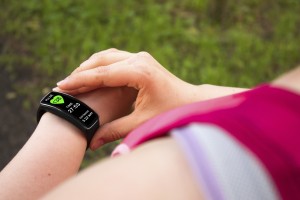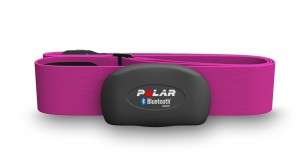Heart Rate Variability: What It Is and Why It’s Important
 When a doctor measures your heart rate, he or she will usually give you a number, typically between 60 and 90 beats per minute. Yet your heart does not beat like an unchanging metronome, i.e., the intervals vary between one heartbeat and the next. Heart Rate Variability (HRV) is the beat-to-beat variation in consecutive heartbeats as shown in electrocardiogram (EKG). So if the number your doctor gives you is 62, your heartbeat is really beating between a range, such as 56 and 70.
When a doctor measures your heart rate, he or she will usually give you a number, typically between 60 and 90 beats per minute. Yet your heart does not beat like an unchanging metronome, i.e., the intervals vary between one heartbeat and the next. Heart Rate Variability (HRV) is the beat-to-beat variation in consecutive heartbeats as shown in electrocardiogram (EKG). So if the number your doctor gives you is 62, your heartbeat is really beating between a range, such as 56 and 70.
Good news: you don’t need an EKG to measure HRV. Allow me to tell you why it’s a good idea to know your how much your heartbeat varies. HRV is a quick and reliable view into the state of your physical — and even mental — health. It is non-invasive and relatively easy to measure with an app and a monitor, and provides a tool to measure your autonomic nervous system, or the part of your nervous system responsible for control of the bodily functions not directed consciously, such as breathing, the heartbeat, and digestive processes. Monitoring your HRV reveals your stress levels and where you are in physical training efforts (should you do that cardio workout at full force today or not?). HRV can also indicate deteriorating health.
Which Is Better: More or Less HRV?
So here’s the deal: the more your heart beat irregularly, the healthier you are! What? Yes, research proves that when your HRV is high or optimized, your body is showing better stress resilience and health. A low HRV (little variation between beats) actually indicates less resilience and greater stress – so a workout may not be a good idea.
Think about this: Your body is always in a state of physiological and emotional change. So a healthy heart rate will vary as your body and mind vary. Your heart rate responds to emotions and external stressors. In fact, when you inhale your heart rate speeds up and when you exhale it slows down.
Since so many of us fall into that “tired but wired” or “need wine to wind down” state of existence, I advise monitoring your HRV and aiming to increase it – which reflects a more balanced nervous system, a better place of balance for your hormones.
 More Variability is Healthy
More Variability is Healthy
HRV tells us about the state of your autonomic nervous system (ANS) activity. The ANS is the master controller over your entire body and mind. It consists of the sympathetic and the parasympathetic nervous systems.
The sympathetic nervous system is our fight-flight-freeze system. When the sympathetic nervous system takes over in the face of stress, danger, or illness, HRV decreases – especially if you have a hard time clearing stress from your body. This shows the body is under persistent stress and may not be able to perform well or heal in the long term, even if it can perform well in the short term. Athletes who overtrain, people who are stressed or eat a poor diet, sedentary folks, people suffering from disease, aging populations, and those with mental conditions such as anxiety, depression and PTSD usually have a low HRV.
The parasympathetic nervous system is our feed-and-breed or rest-and-digest system. It is associated with relaxation, low blood pressure, digestion, and healing. When the parasympathetic nervous system is in control, HRV increases (this is good!). This shows the body is relaxed and balanced. The body can perform better and heal itself – recovery occurs in the parasympathetic nervous system. Healthy people who are eating well and sleeping well, athletes who rest and recover, and those who proactively manage stress usually have a higher HRV.
There are many physical and emotional situations that contribute to excessive sympathetic stimulation. Different patterns of heart activity, or heart rhythm, respond to this stimulation and impact our cognitive abilities, emotional functions and sense of well-being. Many situations—crying kids, traffic jams, incompetent coworkers—stimulate your sympathetic nervous system. Heart rate goes up, HRV goes down, you get stressed, stress stimulates the sympathetic response—you see how it goes! The key is that when you get a stress response, you learn how to clear it, instead of chronically activating it without time for recovery of the system.
Low HRV has been associated with diabetes,((Seyd, P. T. A., et al. “Time and frequency domain analysis of heart rate variability and their correlations in diabetes mellitus.” International Journal of Biological and Life Sciences 4, no. 1 (2008): 24-27.)) belly fat and blood sugar problems (even without diabetes),((Meyer, M. L., et al. “Association of glucose homeostasis measures with heart rate variability among Hispanic/Latino adults without diabetes: the Hispanic Community Health Study/Study of Latinos (HCHS/SOL).” Cardiovascular Diabetology 15, no. 1 (2016): 1.)) hypertension,((Weber, C. S., et al. “Salt-sensitive men show reduced heart rate variability, lower norepinephrine and enhanced cortisol during mental stress.” Journal of Human Hypertension 22, no. 6 (2008): 423-431.)) ((Dekker, J. M., et al. “Low heart rate variability in a 2-minute rhythm strip predicts risk of coronary heart disease and mortality from several causes The ARIC Study.” Circulation 102, no. 11 (2000): 1239-1244.)) ((Umetani, K., et al. “Twenty-four hour time domain heart rate variability and heart rate: relations to age and gender over nine decades.” Journal of the American College of Cardiology 31, no. 3 (1998): 593-601.)) inflammation,((Saito, I., et al. “Impact of heart rate variability on C-reactive protein concentrations in Japanese adult nonsmokers: The Toon Health Study.” Atherosclerosis 244 (2016): 79-85.)) fatty liver,((Liu, Y. C., et al. “Influence of non-alcoholic fatty liver disease on autonomic changes evaluated by the time domain, frequency domain, and symbolic dynamics of heart rate variability.” PloS One 8, no. 4 (2013): e61803.)) and a higher risk of coronary heart disease.((Dekker, J. M., et al. “Low heart rate variability in a 2-minute rhythm strip predicts risk of coronary heart disease and mortality from several causes The ARIC Study.” Circulation 102, no. 11 (2000): 1239-1244.))
Negative emotions (such as hostility and anxiety),((“Allostatic Load Notebook: Heart Rate Variability”, MacArthur Research Network on SES & Health, University of California San Francisco, modified 1997, accessed Feb 2, 2016, http://www.macses.ucsf.edu/research/allostatic/heartrate.php.)) clinical depression and PTSD have also been linked with low HRV.((Carney, R. M., et al. “Depression, heart rate variability, and acute myocardial infarction.” Circulation 104, no. 17 (2001): 2024-2028.)) Researchers followed active duty U.S. marines for five years and assessed them before and after deployment. Their results showed that the marines who had low HRV before deployment were more likely to develop PTSD when they returned home.((Paddock, C. “Low Heart Rate Variability May Influence PTSD Risk,” Medical News Today Sept 11, 2015, accessed Feb 11, 2016, http://www.medicalnewstoday.com/articles/299365.php))
On the other hand, high or optimal HRV is associated with slower aging, lower blood sugar (in 2 days),((McCraty, R., et al. “Heart rate variability, hemoglobin AlC, and psychological health in type 1 and 2 diabetes following an emotional self-management program.” Proceeding of the Society of Behavioral Medicine. 20th Annual Scientific Sessions, San Diego, California (1999).)) and lower blood markers of inflammation, such as high sensitivity C-reactive protein.((Saito, I., et al. “Impact of heart rate variability on C-reactive protein concentrations in Japanese adult nonsmokers: The Toon Health Study.” Atherosclerosis 244 (2016): 79-85.)) Optimal HRV reflects good self-regulation, adaptability, and resilience.((McCraty, R., et al. “The coherent heart: Heart-brain interactions, psychophysiological coherence, and the emergence of system-wide order.” Integral Review 5, no. 2 (2009): 10-115; Segerstrom, S. C., et al. “Heart rate variability reflects self-regulatory strength, effort, and fatigue.” Psychological Science 18, no. 3 (2007): 275-281; McCraty, R., et al. “Heart rate variability: new perspectives on physiological mechanisms, assessment of self-regulatory capacity, and health risk.” Global Advances in Health and Medicine 4, no. 1 (2015): 46-61.))
Measure Your Own HRV
By regularly tracking your HRV, you can:
- Decide what exercise to perform that day, or if you need a day off
- Get real-time feedback on what improves or diminishes your HRV
- Be alert to excess stress, including overtraining
Many options are available to monitor HRV at home, on the go, and while working out. Most require an app and a heart rate monitor. I recommend a chest strap monitor as it is more likely to give a clinical-grade measurement. For apps, try SweetBeat HRV or HeartMath’s Inner Balance Transformation System.
SweetBeat HRV focuses on stress reduction, training, and heart rate recovery. It alerts you when your HRV is too low, prompting you when you need to engage in a stress reduction effort. The training component assesses whether you can train full-out or whether you should have a low-intensity day or even a day off. What you need: a Blue tooth heart rate monitor and the Sweetbeat app.

This is the heart rate monitor that I use.
HeartMath® is based on using positive emotions to achieve health and well-being. Before you roll your eyes at the idea, HeartMath has been shown to lower cortisol (our stress hormone) by 23 percent and major corporations use it to help their employees rebalance emotionally and mentally, as well as to lower their blood pressure and blood sugar. What you need: the HeartMath Inner Balance™ Transformation System sensor that reads your pulse and HRV from your earlobe. Then you get the app at the app store. The full system engages you to modulate your breathing and focus on positive emotions in order to reduce negative stress, improve relaxation, and build resilience. A breathing pacer helps you improve your HRV.
Time to Vary It Up
Once you’ve monitored your HRV, then choose from the following five strategies to improve it:
1. Heart-focused Breathing: Breathe slowly and regularly at a 10-second rhythm (5 seconds on the in-breath and 5 seconds on the out-breath) for 20-30 minutes once per day (twice per day to reduce hot flashes).
2. Consumption of Marine Fats: Habitually consuming fish and fish oil improve HRV.((Mozaffarian, D., et al. “Dietary fish and ω-3 fatty acid consumption and heart rate variability in US adults.” Circulation 117, no. 9 (2008): 1130-1137.)) One study suggested that three times per week helps improve HRV and sleep.(( Hansen, A. L., et al. “Fish consumption, sleep, daily functioning, and heart rate variability.” Journal of Clinical Sleep Medicine: JCSM: Official publication of the American Academy of Sleep Medicine 10, no. 5 (2014): 567.))
3. Exercise has been shown to increase HRV in healthy individuals.((Dixon, E. M., et al. “Neural regulation of heart rate variability in endurance athletes and sedentary controls.” Cardiovascular Research 26, no. 7 (1992): 713-719.)) ((Pichot, V., et al. “Interval training in elderly men increases both heart rate variability and baroreflex activity.” Clinical Autonomic Research 15, no. 2 (2005): 107-115.)) Many studies document improved HRV through exercise, even in patients enrolled in cardiac rehabilitation programs.((Sandercock, G. R. H., et al. “Changes in short-term measures of heart rate variability after eight weeks of cardiac rehabilitation.” Clinical Autonomic Research 17, no. 1 (2007): 39-45.)) One of the best things you can do to improve HRV is to walk in nature – walking in a built environment doesn’t help HRV.((Gladwell, V. F., et al. “A Lunchtime Walk in Nature Enhances Restoration of Autonomic Control during Night-Time Sleep: Results from a Preliminary Study.” International Journal of Environmental Research and Public Health 13, no. 3 (2016): 280.)) Overall, you want to get enough exercise to improve HRV without accumulating excess stress metabolites in your muscles and blood, and then allow adequate recovery time. For instance, my HRV declines immediately after I perform high-intensity interval training (HIIT), and takes about 48 hours to recover to basal levels. Younger fitness enthusiasts like my daughters recover faster, in 24 hours. Other may take 72 hours.
Recovery depends on basal HRV, training status, and intensity of exercise.((Imai, K., et al. “Vagally mediated heart rate recovery after exercise is accelerated in athletes but blunted in patients with chronic heart failure.” Journal of the American College of Cardiology 24, no. 6 (1994): 1529-1535; Seiler, S., et al. “Autonomic recovery after exercise in trained athletes: intensity and duration effects.” Medicine and Science in Sports and Exercise 39, no. 8 (2007): 1366.)) Low HRV is associated with poor strength((Chen, J. L., et al. “Parasympathetic nervous activity mirrors recovery status in weightlifting performance after training.” The Journal of Strength & Conditioning Research 25, no. 6 (2011): 1546-1552.)) and aerobic performance. How do you know if you’ve recovered from exercise? Measure your HRV and see if it’s > 50, indicating you’re ready to train again.
4. Biofeedback: HRV Biofeedback has been used for a variety of issues including anxiety, depression, PTSD,((Berry, M. E. “Cardiac coherence and posttraumatic stress disorder in combat veterans.” Alternative Therapies in Health and Medicine 16, no. 4 (2010): 52.)) performance, cardiac rehabilitation, IBS, hypertension, and more. While there are not extensive controlled studies, the overall results have been positive.((Gevirtz, R. “The promise of heart rate variability biofeedback: evidence-based applications.” Biofeedback 41, no. 3 (2013): 110-120.)) HeartMath has a website full of mostly decent, well-controlled, peer-reviewed research. One study that I can particularly relate to (it used stressed-out physicians as test subjects!) showed that using a biofeedback-based stress management device along with breathing exercises and self-generated positive emotion, resulted in subjects increasing their HRV and reducing their stress.((Lemaire, J. B., et al. “The effect of a biofeedback-based stress management tool on physician stress: a randomized controlled clinical trial.” Open Medicine 5, no. 4 (2011): 154-165.))
5. Positive Emotions: When you call to mind someone whom you love, you activate oxytocin, which has a salutary effect on HRV. To do this, sit with your HRV monitor, and bring to mind a person that you love – it’s best if the relationship is very dear and relatively conflict free (such as my 11-year-old daughter, or a beloved pet). Or think in your mind’s eye a special place that’s very calming for you. Hold that person in your heart, and imaging breathing in and out from your heart for 5 to 10 minutes, and longer if time allows.
Conclusions
I’ve used the Sweetbeat and HeartMath products, and have seen them truly help my patients and me. When I first measured my HRV with Sweetbeat, I was regularly in the 40s, which meant I was too depleted to train hard and under too much stress. After tracking it and applying these principles to improve HRV, I’m now consistently in the 60s, and occasionally break into the 70s. Let me know your experience with HRV in the comment section, particularly your baseline and what has been most helpful to improve your HRV over time.
